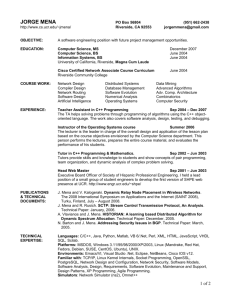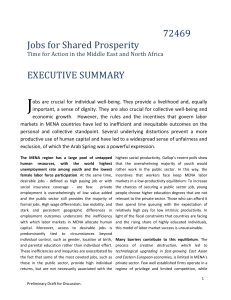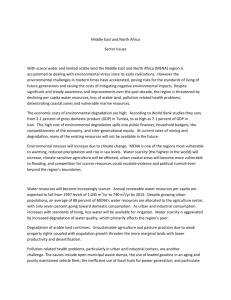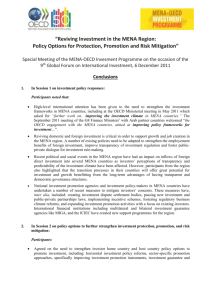Refiguring La Malinche
advertisement
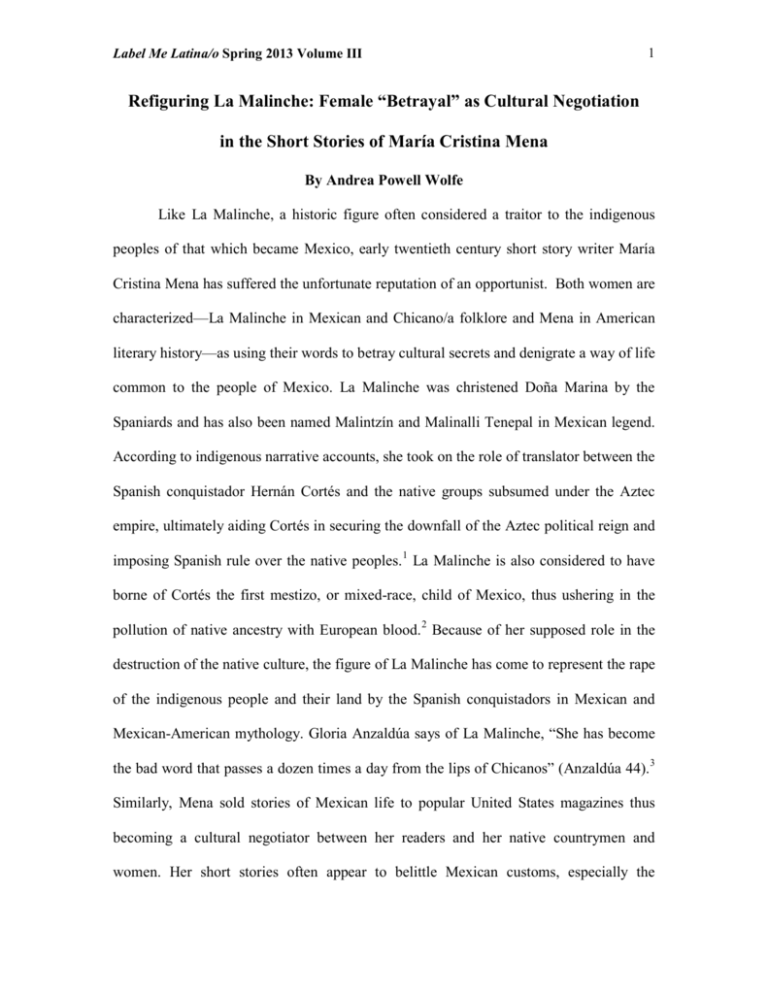
Label Me Latina/o Spring 2013 Volume III 1 Refiguring La Malinche: Female “Betrayal” as Cultural Negotiation in the Short Stories of María Cristina Mena By Andrea Powell Wolfe Like La Malinche, a historic figure often considered a traitor to the indigenous peoples of that which became Mexico, early twentieth century short story writer María Cristina Mena has suffered the unfortunate reputation of an opportunist. Both women are characterized—La Malinche in Mexican and Chicano/a folklore and Mena in American literary history—as using their words to betray cultural secrets and denigrate a way of life common to the people of Mexico. La Malinche was christened Doña Marina by the Spaniards and has also been named Malintzín and Malinalli Tenepal in Mexican legend. According to indigenous narrative accounts, she took on the role of translator between the Spanish conquistador Hernán Cortés and the native groups subsumed under the Aztec empire, ultimately aiding Cortés in securing the downfall of the Aztec political reign and imposing Spanish rule over the native peoples. 1 La Malinche is also considered to have borne of Cortés the first mestizo, or mixed-race, child of Mexico, thus ushering in the pollution of native ancestry with European blood. 2 Because of her supposed role in the destruction of the native culture, the figure of La Malinche has come to represent the rape of the indigenous people and their land by the Spanish conquistadors in Mexican and Mexican-American mythology. Gloria Anzaldúa says of La Malinche, “She has become the bad word that passes a dozen times a day from the lips of Chicanos” (Anzaldúa 44). 3 Similarly, Mena sold stories of Mexican life to popular United States magazines thus becoming a cultural negotiator between her readers and her native countrymen and women. Her short stories often appear to belittle Mexican customs, especially the Label Me Latina/o Spring 2013 Volume III 2 lifestyles and beliefs of the lower-class indios, and to pander to the desire of upper-class U.S. readers to gaze upon native Mexicans as “others” available for consumption through literal and figurative tourism. As women who seemed to profit by working for the enemies of their native people, both La Malinche and Mena are problematic figures for historians and literary theorists attuned to the politics of European colonialism in Mexico and the continued neo-colonialism of Mexico by its Northern neighbor, the United States. Recent Chicana feminism has undertaken to recover La Malinche as more than a traitorous whore, however, claiming her power as a strong female figure. Feminist theorists have shown that not only did La Malinche mediate her own success as an important figure in the new Spanish empire but that she also negotiated for the interests of native groups. In any case, despite the discrepancies in how La Malinche’s personal character is portrayed in history and folklore, we know that she occupied a crucial role in the founding of Mexico as a Spanish colony and that her translations led to the dawn of a new era for Europeans and indigenous peoples alike. As Sandra Messinger Cypress claims, “For many feminist critics today, the use of voice by La Malinche, her role as spokesperson, marks one of the most striking—and positive—disruptions of the patriarchy on both the indigenous and European sides” (Cypress 17). As a woman of power and voice, La Malinche was indeed a rare figure in her time. Furthermore, as legend attributes to her affair with Cortés the creation of the Mexican “race,” her maternal body propagated, in myth at least, the beginning of a nation of truly Mexican people, part European and part Indian. In this way, feminists of the late twentieth and early twenty-first centuries have begun to transform La Malinche into a powerful figure representative of both womb and tongue, one simultaneously maternal and Label Me Latina/o Spring 2013 Volume III 3 revolutionary. 4 For these critics and theorists, La Malinche used her words and her body to birth a new way of life. 5 Thus, some Chicana feminist writers have come to think of La Malinche as an important mother-figure and consider themselves as “carrying out the work she began in the public arena” (Cypess 22). 6 If we think of La Malinche as the mother of Chicana writers, it follows logically to consider Mena one of her first daughters. 7 Not only does Mena’s role as cultural negotiator between Mexicans and European-descended Americans link her to La Malinche who translated between indigenous peoples and the Spanish conquistadors, but Mena’s stories also often address acts of female betrayal—in terms of sexuality as well as voice—and frequently portray these acts as subversive, potentially revolutionary, and communally significant. To grant Mena her place within a rich Chicana literary heritage—to incorporate her stories into the literary canon as significant texts of the early twentieth century—would be a move toward both filling temporal gaps and exploring thematic threads in Chicana literature between María Ampara Ruiz de Burton’s The Squatter and the Don (1885), a depiction of the cultural upheaval precipitated by the Treaty of Guadalupe Hidalgo, and Josefina Niggli’s Mexican Village (1945), a much-later exploration of gender and ethnicity issues in a MexicanAmerican context. In order to open up interpretations of Mena’s role in American and Chicano/a literary history, then, I read Mena’s stories as revisions of La Malinche mythology and Mena herself as a female figure with important and striking parallels to the mythic La Malinche. Although Mena was born and spent most of her childhood in Mexico, her parents sent her to stay with friends in New York before the onset of the Revolution of 1910, and Label Me Latina/o Spring 2013 Volume III 4 she never returned to live in Mexico.8 In 1913, she published her first two stories: “The Gold Vanity Set” in American Magazine and “John of God, the Water-Carrier” in Century Magazine. She continued to write short stories for various popular magazines, most frequently for Century Magazine. Tiffany Ana López comments on the role that Mena filled in writing for the audience of this periodical: “Century Magazine, in deliberately commissioning a Mexican-born author to write about Mexican life for an American audience, literally placed Mena in the role of the cultural translator” (“’Tolerance’” 61). Like the parties for which La Malinche served as negotiator, Mena’s audience depended on her for “truth.” In fact, Mena’s stories represented “real” Mexico for most of her readers, United States citizens who knew very little about life outside of their own national borders. Indeed, Mena took on a position as negotiator of sorts by trading her words not only for personal monetary compensation but also for the potential of building among her U.S. readers an appreciation for the complexities of her native culture. As interpreter of her native culture to readers within her adopted country, however, Mena played a complex role. Amy Doherty admits, “As a struggling writer in New York City, Mena had to deal with the standards of the magazines in which she published” (Doherty Introduction xi). Mena was forced to conceal any critique of her upper-middle-class United States audience in the dominant discourse of U.S. culture, one infused with racial stereotypes of Mexicans and Indians. Doherty continues: Mena had a dual purpose in writing: first, to entertain a privileged, conservative, Anglo audience with a passion for travel and the exotic, an audience which sought a pre-packaged version of another country. Label Me Latina/o Spring 2013 Volume III 5 Second, it was her purpose to comment on the meeting of the U.S. and Mexican cultures both as an “interpreter” and as a critic, a role which she plays most subtly in her fiction. (Doherty Introduction xi) Indeed, Mena does trade in the stereotypes with which her audience would be most familiar and, perhaps like La Malinche, her intent is often misunderstood. Raymund A. Paredes classifies her stories as “trivial and condescending” and claims that although Mena does seem to have a real sympathy for the “downtrodden Indians,” she paints them as simple and picturesque (Paredes 85). As Charlotte Rich points out, Mena’s seemingly patronizing characterizations of Indians in her stories are more likely demonstrations of Baktinian “double-voicing” (Rich 205). Rich claims that although Mena’s narrators “invoke stereotypes about Mexicans, the texts themselves problematize such generalizations, often reversing the expectations set up by such views” (205). By portraying both her American and higher-caste Mexican characters as speaking pejoratively of the indios, “Mena implies the affiliation of the elite class of Mexicans with wealthy Americans, which was often the case during the Díaz regime” (Rich 206). In this way, Mena’s criticisms of U.S. attitudes toward Mexico are disguised through her use of common stereotypes. 9 Mena’s stories also demonstrate her dedication to exploring the problematic influence of the United States on Mexican culture and politics and conveying the complexity of U.S.-Mexican relations to her readership. A good example of this would be her treatment of the consumerism that developed in Mexico in the early 1900s as a result of the economic growth that occurred under President Porfirio Diaz's leadership. In the decades leading up to the Revolution of 1910, Díaz had partnered with U.S. businessmen Label Me Latina/o Spring 2013 Volume III 6 to bring capitalism to Mexico. Doherty explains: “Mexico was unprepared for this rapid growth, and Díaz’s optimistic doctrine of ‘orden, paz y progreso’ (‘order, peace and progress’) had disastrous results for the poor and middle classes” (Introduction xxx). The results of Díaz’s policies included great profits for United States companies and a small proportion of Mexican aristocracy and massive exploitation of working-class Mexicans. Many Mexicans of the lower castes were dispossessed of their land and forced into that which historian Gilbert M. Joseph labels “neofeudal[ism],” a system that kept them in perpetual debt to landowners and bosses (Joseph 46). Letitia M. Garzo-Falcón points out that the U.S. and Mexico, “in complicity with one another, had no apparent concern for the socially and economically deprived, the poor upon whom the burden of their wealth rested” (Garzo-Falcón 133). Furthermore, although revolutionaries fought hard for social reform, the Revolution itself, according to contemporary historians, did little to change the oppression of the middle and working classes: “Indeed, rather than marking a sharp break with the Porfiriato [Diaz’s era of governance], the revisionists argue that the epic revolution would ultimately have the effect of . . . consolidating the increasingly centralized, increasingly capitalistic modern state which had already been emerging during the Díaz period” (Joseph 47). 10 Mena’s stories, then, negotiate space to critique the often exploitative role that United States capitalism and consumerism played in Mexicans economics and politics during her lifetime. Importantly, La Malinche-like female characters are the figures through which Mena frequently interrogates U.S. involvement in Mexico. Because of the extent to which their roles were changing, Mena might have seen Mexican women as available to serve as potential cultural translators in ways that they had not been before. Women who Label Me Latina/o Spring 2013 Volume III 7 lived lives of virtual isolation before the Revolution were now working for the cause in a variety of ways; some even served in militaristic capacities (Doherty Introduction xxx). Mena takes up this theme of changing roles for Mexican women and writes into it female characters who take on active roles in this era of cultural transition: “Mena’s work features women as active and vital parts of cultural and political change; they have the ability to examine how power works as a result of their subject positions as women in patriarchal societies” (López “María” 40). The female characters in Mena’s short stories have not internalized the messages of Malinche mythology: that women should not control their sexual lives, talk too much, or take on too much power. Indeed, instead of confirming La Malinche as La Chingada or “the violated/fucked one,” as she is often figured in popular Mexican mythology, Mena revises the myth surrounding this historic figure in order to depict her as an empowered and communally important agent of revolution. Through her vision of women as cultural translators, mediators, and revolutionaries, Mena demonstrates that, in her stories at least, women can take on active roles in which they “triumph as active and vital participants in cultural and political change” (López “Tolerance” 77). They use their particular insights into the realities of Mexican life to critique alliances between Mexican elites and United States businesses and politicians and to enact change in their communities. Carmelita, of “The Sorcerer and General Bisco” (1915), is an example of a female character who acts as a traitor in order to ultimately effect revolution. Although Mena titles the story for two male characters, it is Carmelita who emerges both as its most complex character and as its foremost hero. At the beginning of the tale, Bisco intends to usurp Don Baltazar Rascón, the sorcerer of the story’s title, of his power and return it to Label Me Latina/o Spring 2013 Volume III 8 the Mexicans of Carmelita’s community, but Rascón gains the upper hand when he convinces Bisco to gaze into his crystal ball. While in a hypnotic state and thus controlled by Rascón, Bisco agrees to arrange for the fatal punishment of both Carmelita and her lover, Aquiles. When he calls the two prisoners into his chambers and informs them of their fates, however, Carmelita argues that Bisco is under the power of the crystal ball. She announces to all present—Bisco, Rascón, and the guards—“General Bisco does not speak with his own voice. His voice was taken away from him when he looked into the crystal” (109). Carmelita carefully mediates the developing relationship between Bisco and Rascón and indeed, speaks when the most powerful man in the room is rendered speechless. Bisco’s hypnosis is ceased and his understanding of Rascón’s motivations is restored by Carmelita’s words, and accordingly, he takes action against the evil sorcerer, swiftly killing him. Thus, Carmelita’s words enact revenge on the Spanish Rascón, the tyrant landowner who had taken Carmelita as his wife after “despoil[ing]” her own family and the other “honest Mexican” families who lived on or near his land; furthermore, they save her own life and that of Aquiles (102). Here, Carmelita’s speech is a powerful force in the community’s uprising against Rascón, just as La Malinche’s speech was powerful in negotiating terms for herself and for the indigenous peoples of the Aztec empire. She is heroic in many ways, but Carmelita is also a traitor in that she betrays her husband, although she was admittedly joined to him under dishonest circumstances. Carmelita leaves Rascón for the young Aquiles who had been placed in his care and then goes on to hand over her husband’s secrets to Bisco, his most powerful enemy. Carmelita’s words, in fact, directly lead to Rascón’s death. Carmelita is thus disloyal to Label Me Latina/o Spring 2013 Volume III 9 her husband with her body and also through her speech. These two particular types of disloyalty align Carmelita with the figure of La Malinche as both Carmelita and La Malinche seemingly enact both sexual and linguistic betrayal. In this way, Mena paints Carmelita as La Malinche’s traitorous counterpart but shows her acts of “betrayal” as ultimately necessary. As a “traitor,” Carmelita chooses her own destiny and frees her people from the tyranny of Rascón. In this story, Mena works through, and indeed indirectly refigures, the myth of La Malinche to portray powerful women as important cultural negotiators during a time of great transition and conflict in Mexican history. In fact, Mena uses Carmelita’s triumph over the sorcerer to issue criticism of the affiliations between the United States and Mexico. The story itself operates on two levels: representation and symbolism. On one hand, “The Sorcerer and General Bisco” is representative of the actual experiences of many Mexican communities around the time of the Mexican Revolution. Bisco, the grassroots revolutionary figure, attempts to overthrow Rascón, the capitalistic landowner who has exploited the lower-caste Mexicans around him. Rascón proves a worthy opponent, however, when he tricks Bisco into perceiving the situation from his point of view. Rascón’s ability to suppress revolutionary forces and redirect them in ways beneficial to himself is perhaps representative of the ways in which Mexican elites manipulated the sincere reform efforts of the poor during the revolutionary period: “Rascón is a capitalist/hypnotist preying on those who are economically oppressed . . . . As a landowner, Rascón understands precisely what hypnosis is all about: the seduction of the consumer and the creation of a dependent subject” (López “María” 36). If the story represents the uprisings taking place in Mexico at the time of its publication, then, Carmelita’s role is as mediator between the Label Me Latina/o Spring 2013 Volume III 10 capitalistic—and, therefore, United States-aligned—Porfirian landowner and the common people of her community. It is only because of Carmelita’s intervention, in fact, that the revolutionary cause is successful in this story. “The Sorcerer and General Bisco” is also widely regarded as an allegorical portrayal of the relationship between Mexico and the United States during the early years of the twentieth century. On this level, Rascón represents the United States and Bisco the Mexican government. This interpretation also shows Rascón as able to manipulate Bisco’s interests. Again, it is Carmelita who “translates” Rascón’s true motivations and saves Bisco and his followers from disaster. Thus, Carmelita takes on a role as the La Malinche-figure who negotiates and ultimately ends exploitation rather than one who ushers in a period of exploitative rule, as La Malinche is often presented in myth. In both interpretations of the story, the security of the Mexican community hinges on Carmelita’s ability to interpret Rascón’s tricks for the misled Bisco. As the wife of the sorcerer, she is the only one who understands Rascón’s tricks and who can force Bisco to see his state of complicity with Rascón’s crimes. Thus, when Carmelita speaks, she becomes Rascón’s biggest threat. As López points out, Rascón attempts to suppress this threat by sexualizing Carmelita (“María” 39). When Bisco starts to gain some awareness of his hypnotic state and wonders why he no longer feels like himself, Rascón claims, “It is the guilty woman. She is possessed, and has tried to bewitch your Excellency” (109). As López asserts, “When her voice cannot be contained by her male oppressor, it is immediately connected to an uncontrollable sexual prowess” (López “Maria” 39). Like La Malinche who supposedly served as mistress to Cortés, Carmelita’s sexuality is blamed “as the cause of her challenge to male power figures” (López, “Maria” 39). Label Me Latina/o Spring 2013 Volume III 11 Clearly, Rascón’s efforts to wrest control of the situation from Carmelita are desperate attempts to reinstate an economy based on relationships between men and, thus, one in which Carmelita would be safely confined to the role of a sexualized commodity. Bisco ultimately sees through Rascón’s attempt to contain Carmelita and her message, however, and heeds the truth of her words. In “Marriage by Miracle” (1916), another female character, Ernestina, also succeeds in outmaneuvering patriarchal attempts to contain her power. Although the opening of the story relegates her to the role of an old maid, Ernestina becomes, like Carmelita, the most powerful figure in her story. The main conflict in “Marriage by Miracle” occurs when Doña Rosalia de Ramos Blancos, Ernestina’s mother, resists the intentions of Luis Maldonado toward her daughter Clarita, Ernestina’s younger sister. Although the upper-class family has suffered financially due to the conditions of the Revolution, Rosalia goes to great lengths to preserve the appearance of her family’s previous standard of living. In keeping with her traditional perception of caste hierarchy, she rejects Luis as a suitor for her daughter because “he was of no family whatever” (116). She does not want to completely alienate her youngest daughter, though, so Rosalia eventually agrees to the marriage of Clarita and Luis. Rosalia’s condition, however, is an impossible one: she says she will allow the couple to marry, but only after her eldest daughter, Ernestina, has secured a mate. Because Ernestina is “hopelessly disfavored, with a nose of ridicule, her eyes like two fleas,” everyone in the family knows that she will not find anyone willing to marry her (115). So, Clarita implores Ernestina to allow a surgeon from the United States to perform cosmetic surgery on her face. At first, Ernestina refuses to “improve” her face, but she soon acquiesces to her sister’s desires: Label Me Latina/o Spring 2013 Volume III 12 “Not until Clarita, in a tearstorm of passion, swore that a refusal would cause her, Clarita, to disgrace forever the name of Ramos Blancos by eloping with her adorer, did the terrified spinster consent, with many prayers, to be made beautiful” (121). Indeed, the plastic surgeon does make Ernestina beautiful, but at a great expense: the surgery leaves her unable to smile. Ironically, although she has many suitors after her surgery, Ernestina decides that she will never marry. Instead, because her new beauty allows her so much influence, Ernestina becomes, like La Malinche, a figure of negotiation and persuades Rosalia to allow the marriage of Clarita and Luis. According to the narrator, both sisters live happily after this incident.11 Although she works to secure marriage for her sister, and thus perhaps participates in the commoditization of another woman, Ernestina boldly subverts the patriarchal expectation that, upon obtaining a conventional form of beauty, she herself would want to marry. Like Malinche, she is a traitor to a culture that would rather she live within the confines of marriage and motherhood than as a single woman of voice and agency, especially since her new beauty allows her so much power. Anzaldúa speaks at length about the expectations placed on Mexican women, claiming, “Women are made to feel total failures if they don’t marry and have children” (Anzaldúa 39). Ernestina’s surgery is meant to make her more suited for marriage, but, because it raises her to such “rarefied heights,” it allows her the power to decide that “a descent to the banality of marriage was out of the question” (123). Furthermore, rather than using the power of her beauty to entrance a man, Ernestina uses it as a tool of negotiation. Ernestina’s beauty gets her on the marriage market, but ultimately, she uses it to undermine the market’s patriarchal power structure. Thus, not only is Ernestina a traitor to the standards of her Label Me Latina/o Spring 2013 Volume III 13 community precisely because she refuses to allow her newly beautified body to be put up for exchange, but she also takes control of her own commoditization. She uses her newly established power to achieve her own goal: to help her sister. Ernestina’s words bring about the marriage of Clarita to a man of a lower caste, at least in her mother’s opinion. Both Ernestina’s body and words, like La Malinche’s, betray the established social order of her community. Moreover, through the development of the character of Ernestina, Mena critiques United States commercialism in Mexico and specifically, its cultural effects for women. The American doctor who performs Ernestina’s surgery is introduced satirically; Clarita finds out “that a surgeon of beauty from the United States had set himself up in the City of Mexico and was anxious, for a consideration, to improve the faces of its inhabitants” (120). This description of the surgeon indicates, and makes fun of, his assumption that Mexican women need a certain kind of improvement in appearance. He wants to sell them “beauty”—an American brand of beauty, that is. When the surgery leaves Ernestina unable to smile, the doctor further reveals his typically American attitude toward Mexico: “In answer to her outcries the surgeon of beauty assured her that an expression of English immobility was in the latest mode cultivated by the most fashionable señoras” (122). As Doherty asserts, this statement confirms the doctor’s “link with colonial powers” (Doherty Introduction xl). It demonstrates the doctor’s cultural assumptions that Mexican women would and should want to fashion their appearances after the appearances of Anglo women. Disturbingly, this comment also suggests the attitude that women are most beautiful when they are unhappy. Mena’s presentation of the surgeon simultaneously draws attention to the ridiculousness of American endeavors to commercialize Mexico Label Me Latina/o Spring 2013 Volume III 14 and to the traditionally patriarchal attitudes toward women that only value them for their beauty, which, of course, draws greater returns for the men who commoditize women on the marriage market. The story indicates that the kind of beauty privileged in the United States, and particularly in popular periodicals like Century Magazine, 12 is not worthy of the reverence that Mena’s readers pay it. Furthermore, if we read Ernestina’s inability to smile as representative of the ways in which U.S. commercialism stunts Mexican economic growth and perverts social equality, “Marriage by Miracle” also suggests that American commercialization is not worth the disfiguration that it causes Mexico. Mena addresses this issue of commercialism in “John of God, the Water-Carrier” (1913) as well, this time with the story of an Indian man’s ascent to holiness. In the story, Mena uses a female figure, Dolores, to save the title character, Juan, from his own inability to change with the times. The story begins when Juan is just a boy and inadvertently causes the death of a peasant woman on her doorstep. Inside the hut, Juan finds Dolores, a young girl who says that she has no family other than her mother. Juan takes Dolores home, and his family cares for her. When Juan leaves the family to work as a water-carrier in Mexico City at the age of sixteen, he promises Dolores that he will marry her upon his return. In Mexico City, however, Juan faces a crisis. He makes his living by bringing water to upper-class Mexicans, but many of the families that he serves have installed indoor plumbing in their homes. They want Juan to pump water into their pipes so that they can utilize their new amenities. Juan refuses and because his customers like him, they allow “the highly painted and patented force-pumps . . . to rust in unlovely idleness” (20). After Juan has worked for several years, his brother, Tiburcio, and Dolores come to visit him in the city. Juan meets with Dolores alone and comes to Label Me Latina/o Spring 2013 Volume III 15 understand that she intends to marry his brother instead of himself. When he and Dolores return to Tiburcio, they find him asleep and physically exhausted. He has spent the afternoon doing that which Juan had refused to do for his customers: Tiburcio had pumped water into their new plumbing systems. Juan and Dolores fear that Tiburcio has been permanently crippled and, therefore, Juan carries him to the Villa de Guadalupe and begs the Virgin to heal him. Tiburcio does recover, but Juan is injured from the long trek to the church. Ultimately, he blesses Tiburcio and Dolores’s marriage and stays on at the church to serve as a water-carrier to visitors. Thus, through narrative twists and turns, Dolores ends up preserving Juan’s dignity and way of life. In fact, Mena presents Dolores as a sort of Christ-like figure from the beginning of the story. When Juan finds her, she is “swaddled in coarse cloth, lying on a straw mat” (13). Similarly, of course, Christ is presented as “swaddled” and lying on straw in traditional Christian legends of his birth in a stable. After Juan adopts Dolores, he takes on more responsibility and starts to earn money; in short, “Juan de Dios was a different person” (15). Just as according to Christian belief a relationship with Christ changes an individual, Dolores transforms Juan’s personality and desires. Finally, when Juan cannot cope with the changes that his profession faces and is most certainly on his way out of a job, Dolores appears again as a significant figure in his life. Although Juan is originally heartbroken by the news of Dolores’s and Tiburcio’s engagement, it begins a chain of events that ends with the preservation of his lifestyle. Dolores’s and Tiburcio’s visit to the city to tell Juan the bad news leads Tiburcio to overexert himself by working at the water pump. His overexertion causes his immobility which, in turn, leads Juan to journey to the Villa de Guadalupe. The journey is torturous for Juan, but he soon Label Me Latina/o Spring 2013 Volume III 16 conditions himself to the role of the martyr: “As he climbed, Juan de Dios prayed, and the more he suffered the more he thanked God. His white cotton trousers gave but the scantiest protection to his knees, and that not for long, yet he did not look for smooth places” (27). In keeping with his new conception of himself as a sacrificial figure, Juan decides to devote his life to God after he reaches the church and Tiburcio is healed. With an elevated sense of self-importance, Juan grants approval of Delores and Tiburcio’s marriage: “Thou, Dolores, and thou, Tiburcio, serve for this earth. Go, and may the good God accompany you always” (28). As Doherty points out, then, the “pilgrimage to the shrine of the Virgin of Guadalupe resolves the conflict between tradition and modernization” (Doherty “Redefining” 170). In this way, Dolores’s decision to marry Tiburcio instead of Juan sets in motion the events that promote Juan to the status of a type of holy man and that allow him to remain of use to others as a water-carrier. She is a powerful figure who, like La Malinche, negotiates for favorable conditions both for herself and for those who play important roles in her life. In “John of God, the Water-Carrier,” we see another of Mena’s female characters’ betrayal transformed into a positive act, just as La Malinche’s traitorous behavior is currently being refigured by feminists as indicative of her strength and power. At least in Juan’s opinion, Dolores is a traitor. She betrays Juan’s trust by arranging to marry his brother in his absence. When he first learns of Dolores’s decision, Juan beats her and “[speaks] bitter reproaches of ingratitude and perfidy” (23). Significantly, just as La Malinche betrays with her tongue, it is Dolores’s speech that finally reveals the full extent of her betrayal to Juan and leads to her beating. She asks Juan, “Where is Bucho?” (23). At this point, Juan understands: “The endearing diminutive of his brother’s name, Label Me Latina/o Spring 2013 Volume III 17 or the tone of instinct in which it was uttered, told him all” (23). Thus, like La Malinche, Carmelita, and Ernestina, Dolores is a traitor in both body and words. Furthermore, this story demonstrates Mena’s subversion of the patriarchal order of the marriage market. In fact, Dolores boldly removes herself from the market altogether by choosing to marry based on her own desires rather than deferring to Juan’s plans for her. At the end of the story, Juan believes that he has the power to give Dolores to Tiburcio, but in reality, Dolores had already chosen Tiburcio herself. In this way, a seemingly traitorous woman, like La Malinche, is refigured as a positive female figure with power and agency. This story also serves as a conduit through which Mena comments on issues of modern “convenience.” “John of God, the Water-Carrier” shows the effects of elite consumerism for the poor of Mexico. As Doherty points out, “Although Mena’s stereotype of the ‘quaint’ Indian may appeal to her United States audience, she also shows the reader the detrimental effects of U.S. capitalism” (Doherty Introduction xxxii). The Indians in the story are presented as simple and picturesque; however, the two brothers demonstrate two possible responses to U.S. capitalism and how neither of these allows for long-term positive results for the Indian. Juan simply refuses to change his style of servitude to better suit it to the changing needs of his customers. Tiburcio, on the other hand, embraces the new trend of in-door plumbing and the temporary recognition that the opportunity to pump water into these pipes affords him: “ . . . although Tiburcio’s muscles were not hardened to such labor he kept at it, his spirit swimming in the ether of pride and praise, for half an hour . . . . and so flattering were the overtures made to him that Tiburcio, concealing his fatigue, addressed himself with zeal to the other two forcepumps” (22). For his hard labor, Tiburcio earns a few silver pieces. Tiburcio is thus used Label Me Latina/o Spring 2013 Volume III 18 and then left to the physical effects of this use. Tiburcio’s experience is symbolic of the widespread exploitation of Indian labor for the profit of the rich of the companies that sell new products and for the convenience of those who enjoy these new products. Furthermore, although Juan’s lifestyle is preserved at the end of the story, he is ultimately depicted as quite a pathetic figure. He decides that he is unable to relate to women and swears off any further contact with them: “The love of woman confounds me too much” (28). Also, he is permanently “crippled” from the damage that his knees suffered during his journey to the church and spends the rest of his life serving travelers, people who pass in and out of his life quickly (28). Mena couches Juan’s inability to face the real world in terms of a failed romance with Dolores, but Dolores and Juan’s story effectively demonstrates that United States commercialism in Mexico uses and discards lower-class laborers and, ultimately, leaves them with no access to the wealth garnered by the elite. 13 In each of the three stories, “The Sorcerer and General Bisco,” “Marriage by Miracle,” and “John of God, the Water-Carrier,” María Cristina Mena uses a female character to comment on the role of the United States in Mexico’s economic and social affairs. Interestingly, these characters, Carmelita, Ernestina, and Dolores, are all traitorous figures—they betray established social codes or patriarchal controls. Rather than allow themselves to become objects of exchange between men, these women take on active roles as translators, negotiators, and revolutionaries. Carmelita sees through the tricks of the landowner who had exploited her and members of her community and convinces General Bisco to kill him. She leads her people through an uprising against a system with which Mena’s readers were most certainly complicit. Ernestina wrests control of her commoditized body and uses it to negotiate toward her own ends. She Label Me Latina/o Spring 2013 Volume III 19 shows her newly-bought United States brand of beauty to be a mockery and refuses to play the role that her American surgeon designs for her. Dolores takes on the role of savior as she preserves the lifestyle of an exploited Indian and secures space for female agency within courtship and marriage. Her story also shows the negative effects of United States commercialism in Mexico. In each of these scenarios, Mena rewrites the mythology surrounding La Malinche—mythology that often works to contain female bodily power and speech—to show Mexican women in positive and active roles during Mexico’s transitional period of the early part of the twentieth century. More than just a popular magazine writer of exotic stories set in Mexico, Mena herself lived out a revised version of La Malinche’s history by taking on an active role as translator of her original Mexican culture to the American audience reading her tales. Not only did Mena work toward the deconstruction of the Malinche mythology and the lasting limitations it imposed on women’s lives, but she also modeled a positive version of assertive Mexican womanhood, one in which a woman’s words can be used to effect positive social change instead of to merely signify either acts of betrayal or victimization. Like La Malinche herself, Mena can be interpreted as a positive mother figure for contemporary Chicana writers and feminists. Mena deserves recognition as a MexicanAmerican female writer who uses double-voicing and complex characterization to speak to the social and political maladies of her day and, more generally, as an important figure of Chicana literature during the early part of the twentieth century. 20 Label Me Latina/o Spring 2013 Volume III Works Cited Alcalá, Rita Cano. “From Chingada to Chingona: La Malinche Redefined, Or A Long Line of Hermanas.” Azlán 26.2 (2001): 33-61. Print. Anzaldúa, Gloria. Borderlands/La Frontera: The New Mestiza. 2nd ed. San Francisco: Aunt Lute, 1999. Print. Cypress, Sandra Messinger. “’Mother’ La Malinche and Allegories of Gender, Ethnicity and National Identity in Mexico” in Romero, Rolando and Amanda Nolacea Harris, ed. Feminism, Nation and Myth: La Malinche. Houston, TX: Arte Público Press, 2005. 14-27. Print. Doherty, Amy. “Introduction” in Mena, María Cristina. The Collected Stories of María Cristina Mena. Ed. Amy Doherty. Houston, TX: Arte Público Press, 1997. vii-1. Print. ---. “Redefining the Borders of Local Color Fiction: María Cristina Mena’s Short Stories in the Century Magazine.” The Only Efficient Instrument: American Women Writers and the Periodical, 1837-1916. Ed. Aleta Feinsod Cane and Susan Alves. Iowa City: University of Iowa Press, 2001. 165-78. Print. Garzo-Falcón, Leticia M. “María Cristina Mena’s Elite, Fermina Guerra’s ‘Folk’: The Struggles of Their Distinct and Converging Worlds.” Gente Decente: A Borderlands Response to the Rhetoric of Dominance. Austin: University of Texas Press, 1998. 133-55. Print. Joseph, Gilbert M. “Mexico’s ‘Popular Revolution’: Mobilization and Myth in Yucatan, 1910-1940.” Latin American Perspectives 6.3 (1979): 46-65. Print. Label Me Latina/o Spring 2013 Volume III 21 Leon-Portilla, Miguel, ed. The Broken Spears: The Aztec Account of the Conquest of Mexico. 2nd Ed. New York: Beacon Press, 2006. Print. López, Tiffany Ana. “’A Tolerance for Contradictions’: The Short Stories of María Cristina Mena.” Nineteenth-Century American Women Writers: A Critical Reader. Ed. Karen L. Mena. Malden, MA: Blackwell, 1998. 62-80. Print. ---. “Maria Cristina Mena: Turn-of-the-Century La Malinche, and Other Tales of Cultural (Re)Construction.” Tricksterism in Turn-of-the-Century American Literature: A Multicultural Perspective. Ed. Elizabeth Ammons and Annette White-Parks. Hanover, NH: University Press of New England. 21-45. Print. Mena, María Cristina. The Collected Stories of María Cristina Mena. Ed. Amy Doherty. Houston, TX: Arte Público Press, 1997. Print. Niggli, Josefina. Mexican Village. Chapel Hill: University of North Carolina Press, 1945. Print. Paredes, Raymund A. “Special Feature: The Evolution of Chicano Literature.” MELUS 5.2 (1978): 71-110. Print. Paz, Octavio. “The Sons of La Malinche.” The Labyrinth of Solitude: The Other Mexico, Return to the Labyrinth of Solitude, Mexico and the United States, the Philanthropic Ogre. New York: Grove Press, 1994. 65-88. [1950] Print. Pratt, Mary Louise. “’Yo Soy La Malinche’: Chicana Writers and the Poetics of Ethnonationalism.” Callaloo 16.4 (1993): 859-73. Print. Rich, Charlotte. “’The Highly Original Country of the Yanquis’: Dramatic Irony and Double-Voicing as Cultural Critique in María Cristina Mena’s Fiction.” Legacy 18.2 (2001): 205-215. Print. Label Me Latina/o Spring 2013 Volume III 22 Romero, Rolando and Amanda Nolacea Harris, ed. Feminism, Nation and Myth: La Malinche. Houston, TX: Arte Público Press, 2005. Print. Ruiz de Burton, María Ampara. The Squatter and the Don. Intro. Ana Castillo. Modern Library Classics. New York: Random House, 2004. [1885] Print. Simmen, Edward. “The Mountain Came Long Ago to Mohammad: The American Cultural Invasion of Mexico as Seen in the Short Fiction of Maria Cristina Mena.” Journal of American Culture 20.2 (1997): 147-52. Print. Storm, Delilah Anne. Retextualized Transculturations: The Emergence of La Malinche as Figure in Chicana Literature. Dissertation University of Illinois at UrbanaChampaign, 1994. Ann Arbor, MI: UMI Dissertation Services, 1994. Print. Tardanico, Richard. “Revolutionary Mexico and the World Economy: The 1920s in Theoretical Perspective.” Theory and Society 13.6 (1984): 757-72. Print. Velázguez Treviño, Gloria. “Cultural Ambivalence in Early Chicana Literature.” European Perspectives on Hispanic Literature of the United States. Ed. Genevieve Fabre. Houston; Arte Público Press, 1988. 140-46. Print. 1 See Miguel Léon-Portillo’s The Broken Spears: The Aztec Account of the Conquest of Mexico, which collects Nahuatl-language accounts of events related to the Spanish Conquest. 2 Evidence indicates that this son, named Martín Cortés, was indeed not the first mestizo. See Sandra Messinger Cypess’s discussion of Gonzalo Guerrero, a shipwrecked Spaniard who bore children with an Indian woman and who chose to stay with his Indian community even after the conquistadors arrived. 3 For perhaps the most well-known exploration of La Malinche as a victimized and traitorous mother-figure in Mexican and Chicano/a mythology, see Octavio Paz. 4 Arte Público Press published a book-length study, edited by Rolando Romero and Amanda Nolacea Harris, on feminist representations of La Malinche in 2005. 5 For an alternative positive reading of La Malinche, see Rita Cano Alcalá, who explores La Malinche as both daughter and sister, instead of focusing on her as a problematic and/or empowering mother-figure. 6 See Mary Louise Pratt and Delilah Anne Storm for further discussion of the feminist reclamation of La Malinche in Chicana literature. 7 The historical Malinche did bear one daughter, named María Jaramillo, with the Spaniard Juan Jaramillo, whom she married after the fall of the Aztec empire to the Spanish. This daughter has been largely Label Me Latina/o Spring 2013 Volume III 23 forgotten, arguably like Mena herself. See Acalá for further discussion of María Jaramillo’s life, including her struggle to reclaim her inheritance and her mother’s place in history. 8 For more on Mena’s life, see Edward Simmen. 9 For more on Mena’s use of stereotypes, see Amy Doherty’s other essay on Mena, “Redefining the Borders of Local Color Fiction: María Cristina Mena’s Short Stories in the Century Magazine,” which considers Mena’s manipulation of the conventions of local color and regionalist writing. Tiffany Ana López (“María Cristina Mena: Turn-of-the-Century La Malinche, and Other Tales of Cultural (Re)Construction”), Leticia M. Garza-Falcón (“María Cristina Mena’s Elite, Fermina Guerra’s ‘Folk’: The Struggles of Their Distinct and Converging Worlds”), and Gloria Velázguez Treviño (“Cultural Ambivalence in Early Chicana Literature”) also address issues of double-speaking. 10 See Richard Tardanico for a summary of revisionist theories on the Mexican Revolution of 1910. Gilbert M. Joseph also discusses whether or not the Revolution achieved any effect for the poor of Mexico. 11 See Tiffany Ana López’s “‘A Tolerance for Contradictions’: The Short Stories of Maria Cristina Mena” for an alternate reading of the ending. López claims that Mena employs irony here to depict marriage as equivalent to living life without a smile. 12 In “Maria Cristina Mena: Turn-of-the-Century La Malinche, and Other Tales of Cultural (Re)Construction,” Tiffany Ana Lopez details the presentation, and indeed the idealization, of a particularly “white” kind of beauty in advertisements appearing in Century Magazine. 13 For an alternative reading of the ending of this story, see Amy Doherty’s Introduction, which suggests that Juan rebels against capitalism.


